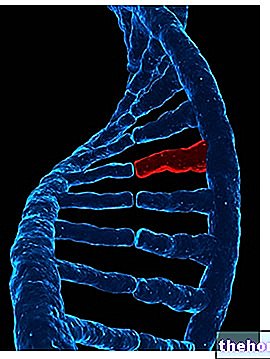Generality
Small cell lung cancer (SCLC) is a tumor process characterized by "high malignancy.

Initial symptoms of small cell lung cancer include persistent cough, difficulty breathing, and chest pain. Diffusion by contiguity to nearby structures can, on the other hand, cause hoarseness, dysphagia and superior vena cava syndrome, due to the compressive effect of the neoplastic mass.
The onset of small cell lung cancer is closely related to cigarette smoking and is rarely seen in a person who has never smoked.
Small cell lung cancer is often characterized by very rapid growth, so it can quickly spread outside the chest, causing widespread metastases. For these reasons it is generally not attackable with surgical therapy.
Causes
Small cell lung cancer is characterized by the uncontrolled growth of cells from the bronchial lining epithelium.
Also known as an oatmeal tumor or microcytoma, this carcinoma owes its name to the small size of the tumor cells that can be seen under a microscope.
Small cell lung cancer consists, in fact, of tumor clones with scarce cytoplasm and well-defined margins, round or oval in shape, sometimes lymphocyte-like. In addition, some types of SCLC may have spindle or polygonal elements.
Cancer cells organize themselves into clusters or masses that do not show glandular or squamous architecture. Some of these neoplastic clones also have neurosecretory granules (cells of the APUD system).
The pathogenetic event triggering the onset of small cell lung cancer is to be found in the mutation of the genes that stimulate cell growth (cMyc, MYCN and MYCL) and the inhibition of apoptosis (BCL-2). Further elements involved are onco-suppressors (p53), whose inactivation justifies the peculiar neoplastic progression of this type of tumor.
In any case, respiratory epithelial cells need prolonged exposure to carcinogens and accumulate multiple genetic aberrations before becoming neoplastic.
Epidemiology
About 15-20% of lung cancer cases are of the small cell type; all other cancers are "non-small cell".
SCLC almost always occurs in smokers and occurs mainly in middle-aged people (27-66 years).
Risk factors
- Tobacco smoke. Cigarette smoking is undoubtedly the main risk factor for the development of small cell lung cancer; only in a minority of cases does the cancer occur in non-smokers. The risk varies according to the intensity and duration of this habit and may decrease after the cessation of the habit, but it can never be comparable to that of someone who has never smoked. The onset of the tumor can also be favored by passive smoking.
- Professional Risks. In smokers, the risk of small cell lung cancer is higher with combined exposure to ionizing radiation or certain substances (for example: asbestos, bis-chloromethyl ether, carbon fumes, silica, cadmium, chromium and nickel) in the workplace.
- Air contamination. Other risk factors implicated in the development of small cell lung cancer include exposure to radon gas, a decay product of naturally occurring radioactive elements in soil and rocks, such as radium and uranium, which can accumulate indoors. Air pollution can also increase the risk of developing this type of cancer.
- Family history and previous lung diseases. Some diseases of the respiratory tree (such as tuberculosis, COPD and pulmonary fibrosis) can increase the predisposition to lung cancer, as well as a positive family history for this form of cancer (especially in parents or siblings) and previous treatment of lung cancer. radiotherapy (used, for example, for a lymphoma).
Signs and symptoms
Compared to other lung cancers, small cell cancer is highly malignant, therefore it is extremely aggressive and spreads very quickly.
The symptoms are caused by the local invasion of the tumor, by the involvement of adjacent organs and by metastases.
Cancer cells can migrate lymphatically to the lymph nodes or through the bloodstream.
In several cases, small cell lung cancer is asymptomatic in its early stages or causes nonspecific manifestations; Sometimes, the disease is found accidentally in chest imaging tests done for other reasons.




























